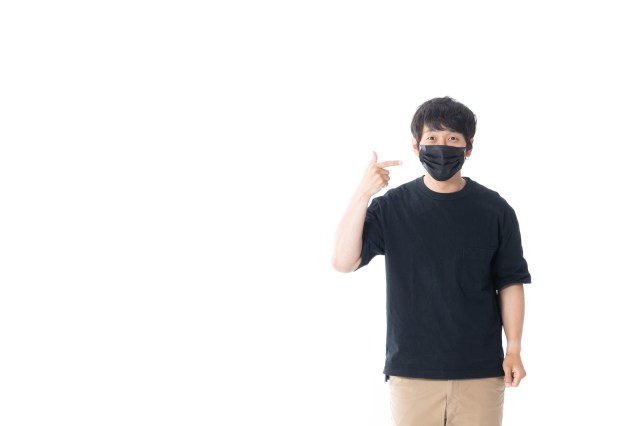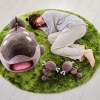
Japanese researchers use mannequin heads to prove that face coverings really do work against COVID-19.
After over half a year of flip-flopping from the international medical community and the World Health Organisation on the efficacy of masks, Japanese researchers have now proven that face coverings help to reduce coronavirus transmission.
Professors at the University of Tokyo’s Institute of Medical Science made the world-first confirmation using actual coronavirus particles in a controlled setting.
The protective effect of masks was tested using a mannequin head connected to a nebuliser that released coronavirus particles from the mouth at the same speed as a human cough. Another mannequin, breathing at the same rate as a human, was placed opposite to gauge the effectiveness of various masks against the virus.
Results revealed that cloth masks blocked 20-40 percent of virus particles, while N95 surgical masks blocked 80-90 percent of particles.
▼ How the “world-first” breakthrough was made.
When the mask was placed on the mannequin releasing the virus, the amount of virus inhaled by the test subject opposite was greatly reduced, even when it was unmasked.
When both mannequins wore a mask, the risk of transmission was further reduced, although this didn’t completely stop the virus from being released into the air.
Reactions to the news online revealed an overwhelming majority were in support of the scientific findings.
“People who think masks aren’t effective need to reflect on this.”
“Anti-maskers still won’t care — they’ll probably think there’s no point in wearing a mask if it doesn’t offer 100-percent protection.”
“I can’t believe it’s taken the world so long to actually test masks like this.”
“Doesn’t it just feel better to wear a mask at the moment? I feel worried if my mouth isn’t covered.”
“People who refuse to wear masks without a valid medical reason are selfish.”
Researchers say masks should be used in conjunction with other countermeasures, such as proper washing of hands, in order to further reduce the risk of virus transmission. And after seeing supercomputer simulations of how easily the virus can spread, proper social distancing and screens in the workplace also work too.
Source: Hachima Kikou
Top image: Pakutaso
● Want to hear about SoraNews24’s latest articles as soon as they’re published? Follow us on Facebook and Twitter!

 Japan creates world’s first edible face mask…from melon bread
Japan creates world’s first edible face mask…from melon bread Nara University study finds some common teas can neutralize COVID-19
Nara University study finds some common teas can neutralize COVID-19 Kobe hospital robbed of 6,000 surgical masks
Kobe hospital robbed of 6,000 surgical masks Mask rules in Japan have changed…so are people still wearing them?
Mask rules in Japan have changed…so are people still wearing them? Naomi Osaka’s first wave of charity face masks sell out, but she promises more for everyone
Naomi Osaka’s first wave of charity face masks sell out, but she promises more for everyone McDonald’s new Happy Meals offer up cute and practical Sanrio lifestyle goods
McDonald’s new Happy Meals offer up cute and practical Sanrio lifestyle goods All-you-can-drink Starbucks and amazing views part of Tokyo’s new 170 meter-high sky lounge
All-you-can-drink Starbucks and amazing views part of Tokyo’s new 170 meter-high sky lounge Studio Ghibli glasses cases let anime characters keep an eye on your spectacles
Studio Ghibli glasses cases let anime characters keep an eye on your spectacles Super Nintendo World expansion gets delayed for several months at Universal Studios Japan
Super Nintendo World expansion gets delayed for several months at Universal Studios Japan We try out “Chan Ramen”, an underground type of ramen popular in the ramen community
We try out “Chan Ramen”, an underground type of ramen popular in the ramen community Studio Ghibli releases new action figures featuring Nausicaä of the Valley of the Wind characters
Studio Ghibli releases new action figures featuring Nausicaä of the Valley of the Wind characters Kyoto’s 100 Demons yokai monster parade returns!
Kyoto’s 100 Demons yokai monster parade returns! Osaka’s creepy cute mascot speaks for first time, adds more fuel the creepy OR cute debate【Video】
Osaka’s creepy cute mascot speaks for first time, adds more fuel the creepy OR cute debate【Video】 Doraemon found buried at sea as scene from 1993 anime becomes real life【Photos】
Doraemon found buried at sea as scene from 1993 anime becomes real life【Photos】 Giant Clodsire Pokémon plushie comes with up to 32 Woopers in super size, super cute set【Pics】
Giant Clodsire Pokémon plushie comes with up to 32 Woopers in super size, super cute set【Pics】 More foreign tourists than ever before in history visited Japan last month
More foreign tourists than ever before in history visited Japan last month Disney princesses get official manga makeovers for Manga Princess Cafe opening in Tokyo
Disney princesses get official manga makeovers for Manga Princess Cafe opening in Tokyo Starbucks reopens at Shibuya Scramble Crossing with new look and design concept
Starbucks reopens at Shibuya Scramble Crossing with new look and design concept Beautiful new Final Fantasy T-shirt collection on the way from Uniqlo【Photos】
Beautiful new Final Fantasy T-shirt collection on the way from Uniqlo【Photos】 Is the new Shinkansen Train Desk ticket worth it?
Is the new Shinkansen Train Desk ticket worth it? Foreign English teachers in Japan pick their favorite Japanese-language phrases【Survey】
Foreign English teachers in Japan pick their favorite Japanese-language phrases【Survey】 Beautiful Sailor Moon manhole cover coasters being given out for free by Tokyo tourist center
Beautiful Sailor Moon manhole cover coasters being given out for free by Tokyo tourist center Studio Ghibli releases Kiki’s Delivery Service chocolate cake pouches in Japan
Studio Ghibli releases Kiki’s Delivery Service chocolate cake pouches in Japan Japan’s bone-breaking and record-breaking roller coaster is permanently shutting down
Japan’s bone-breaking and record-breaking roller coaster is permanently shutting down New definition of “Japanese whiskey” goes into effect to prevent fakes from fooling overseas buyers
New definition of “Japanese whiskey” goes into effect to prevent fakes from fooling overseas buyers Our Japanese reporter visits Costco in the U.S., finds super American and very Japanese things
Our Japanese reporter visits Costco in the U.S., finds super American and very Japanese things Studio Ghibli unveils Mother’s Day gift set that captures the love in My Neighbour Totoro
Studio Ghibli unveils Mother’s Day gift set that captures the love in My Neighbour Totoro Domino’s Japan now sells…pizza ears?
Domino’s Japan now sells…pizza ears? New Japanese KitKat flavour stars Sanrio characters, including Hello Kitty
New Japanese KitKat flavour stars Sanrio characters, including Hello Kitty One of Tokyo’s most famous meeting-spot landmarks is closing for good
One of Tokyo’s most famous meeting-spot landmarks is closing for good Kyoto creates new for-tourist buses to address overtourism with higher prices, faster rides
Kyoto creates new for-tourist buses to address overtourism with higher prices, faster rides Sales of Japan’s most convenient train ticket/shopping payment cards suspended indefinitely
Sales of Japan’s most convenient train ticket/shopping payment cards suspended indefinitely Sold-out Studio Ghibli desktop humidifiers are back so Totoro can help you through the dry season
Sold-out Studio Ghibli desktop humidifiers are back so Totoro can help you through the dry season Japanese government to make first change to romanization spelling rules since the 1950s
Japanese government to make first change to romanization spelling rules since the 1950s Ghibli founders Toshio Suzuki and Hayao Miyazaki contribute to Japanese whisky Totoro label design
Ghibli founders Toshio Suzuki and Hayao Miyazaki contribute to Japanese whisky Totoro label design Tokyo’s most famous Starbucks is closed
Tokyo’s most famous Starbucks is closed One Piece characters’ nationalities revealed, but fans have mixed opinions
One Piece characters’ nationalities revealed, but fans have mixed opinions We asked a Uniqlo employee what four things we should buy and their suggestions didn’t disappoint
We asked a Uniqlo employee what four things we should buy and their suggestions didn’t disappoint Princesses, fruits, and blacksmiths: Study reveals the 30 most unusual family names in Japan
Princesses, fruits, and blacksmiths: Study reveals the 30 most unusual family names in Japan Japanese fashion company develops fabric mask with velcro-edge eating technology
Japanese fashion company develops fabric mask with velcro-edge eating technology Demon Slayer manga creator offers a motivational illustration during the pandemic
Demon Slayer manga creator offers a motivational illustration during the pandemic Japanese mouthwash effective against coronavirus, according to Osaka Governor
Japanese mouthwash effective against coronavirus, according to Osaka Governor Masks should still be worn indoors, majority of Japanese people in poll say
Masks should still be worn indoors, majority of Japanese people in poll say Could Coronavirus be helping prevent the spread of influenza? Japanese Twitter speculates
Could Coronavirus be helping prevent the spread of influenza? Japanese Twitter speculates Japanese government may encourage people to reuse masks as coronavirus-caused shortage continues
Japanese government may encourage people to reuse masks as coronavirus-caused shortage continues We test out Uniqlo’s “new and improved” Airism mask for form, fashion, and function
We test out Uniqlo’s “new and improved” Airism mask for form, fashion, and function Man kicked out of Japan’s national college entrance exam for improper mask-wearing technique
Man kicked out of Japan’s national college entrance exam for improper mask-wearing technique Hyogo Prefecture to give 320,000 fans to restaurants for customers to cover mouths, dine “safely”
Hyogo Prefecture to give 320,000 fans to restaurants for customers to cover mouths, dine “safely” Hot spring in Gunma Prefecture found to reduce COVID-19 infectivity by over 90 percent
Hot spring in Gunma Prefecture found to reduce COVID-19 infectivity by over 90 percent Beyond face masks – Japanese company selling anti-infection paper helmets【Photos】
Beyond face masks – Japanese company selling anti-infection paper helmets【Photos】 Chinese people hand out free surgical masks in Japan as coronavirus outbreak continues【Video】
Chinese people hand out free surgical masks in Japan as coronavirus outbreak continues【Video】 100-yen store Daiso teaches us how to make our own cloth face masks
100-yen store Daiso teaches us how to make our own cloth face masks Politician’s disgusting mask gaffe grosses out Japan【Video】
Politician’s disgusting mask gaffe grosses out Japan【Video】 New coronavirus cases in Tokyo drop to lowest level in almost two weeks
New coronavirus cases in Tokyo drop to lowest level in almost two weeks
Leave a Reply